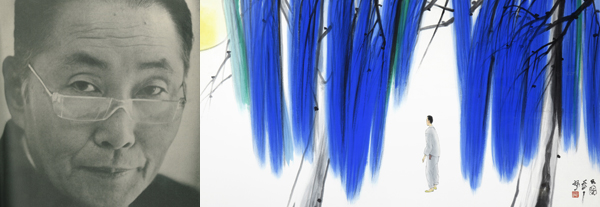Park No-soo dies at 86, leaving behind a trailblazer’s legacy

Park No-soo, left, died on Monday. He painted “Ryuha,” right. [JoongAng Ilbo]
Park No-soo, renowned as one of Korea’s first ink painters since independence from Japanese colonial rule, died on Monday. He was 86.
Drawing from his formal education at Seoul National University’s College of Arts, Park was able to launch a new era for Korean painters at a time when they were struggling for their own identities among strong Japanese influence.
He made a name for himself with controlled colors and simple drawings reinterpreted in a modern way.
Feelings of solitude pulsed through most of the award-winning artist’s works, true to his impression of art as a rough and lonely vocation.
One of his famous pieces depicts a boy standing in the middle of a navy-colored mountain and sends viewers into deep contemplation.
Park began his career under the mentorship of legendary artist Lee Sang-beom (1897-1972) and also drew inspiration from Go Hui-dong (1886-1965), the first Korean painter to adopt Western style.
In 1955, he went on to win the Presidential Award at the Korean Fine Arts Exhibition in the Korean ink and color painting category for “Seonsowoon.”
After working as a professor of fine arts at Ewha Womans University from 1956 to 1962 and at Seoul National University from 1962 to 1982, he was honored with the National Academy of Arts Award in 1987 and the Silver Crown Order of Cultural Merit in 1995.
He was also a member of the National Academy of Arts,
Park’s health deteriorated in 2003, keeping him away from the art world, but his passionate followers didn’t forget him.
In 2010, they organized a retrospective exhibit at the National Museum of Contemporary Art at Deoksu Palace.
Last year, the artist donated 1,000 pieces from his own collection to Jongno District in central Seoul.
In order to honor the gift and the legacy of the man himself, officials there will open a museum in his name by renovating his home in Okin-dong.
The site where the artist lived was previously designed as Seoul Cultural Material No. 1.
During a short period of good health, the painter planted Japanese apricot trees in his garden, and they will soon blossom among Park’s best-known works in a memorial to his legacy.
Despite his advanced age, Park managed to remain young and innocent in spirit for many years.
His attitude is exemplified in an interview he once gave to a daily newspaper.
In the sit-down interview, he told a reporter, “While waiting for spring, my nervous heart shines brightly with mysterious and varied dreams.”
He is survived by his wife, Jang Shin-ae, two sons and four daughters.
Park Chan-kyu is a professor at Korea Advanced Institute of Science and Technology (Kaist), and Park Min-kyu is a senior researcher at the Korea Institute of Ocean Science and Technology.
Actress Lee Min-jung is Park’s granddaughter.
By Kwon Keun-young [estyle@joongang.co.kr]










with the Korea JoongAng Daily
To write comments, please log in to one of the accounts.
Standards Board Policy (0/250자)